My First Trip to the Kennedy Space Center
Rockets, spaceships, and launch pads – Oh, my! Plus, a bonus Viking launch
Exploring the intersection of spaceflight history, pop culture, and space art.
In this edition of Creating Space, I set the Wayback Machine to 1975 when I made the first of many trips to the Kennedy Space Center in Florida.
Are you new to Creating Space? It’s the NERDSletter that explores the intersection of spaceflight history, pop culture, and space art. You can find this and all other posts at creating-space.art.
Set the Wayback Machine to 1975
Fifty years ago this month, as of this writing, I made my first trip to the Kennedy Space Center (KSC). It would not be my last.
In the summer of 1975, I was fifteen years old, and I had just completed my freshman year of high school. Long hair for men, winged hairdos for women, and bell-bottom pants for everyone were in. And NASA was basking in the successes of their first fourteen years of human spaceflight.
Being a young teenager, I of course did not make the trip to Florida alone. I was along for the ride on one of my family’s traditional educational vacations along the east coast of the United States. When we weren’t spending leisure time at the beaches of Maryland and Delaware, our instructional destinations included Plymouth Rock in Massachusetts to see where the Pilgrims landed; Jamestown, Virginia to see how early Virginia settlers had lived; Colonial Williamsburg to learn how our country got its start; Hershey, Pennsylvania and the chocolate factory; Corning, New York and the glass factory; Kitty Hawk, North Carolina to see where the Wright Brothers first flew; Niagara Falls, and the New York World’s Fair.
All of those trips were fascinating to me, and if my parents’ goals were to feed my curiosity and ignite my interest in history, I would say they succeeded greatly.
My father was interested in aviation and spaceflight, among other things. He worked as a civilian for the U.S. Air Force as an illustrator for most of his career. I picked up his interests through the aerospace-related magazines and books he would bring home and the air shows we would attend. And, since I had followed NASA’s space program from the first moments I had become aware of the Apollo missions, I was already primed for our trip to the Kennedy Space Center to see the place where all those rockets had launched.
The trip, itself, was novel in my experience in that we drove south from Virginia to Florida but took the Auto Train back home. The car went along for the ride on the return trip tucked away inside one of the train cars. Apparently, Amtrak still operates this unusual service. I think the way my parents chose to take the trip makes a lot of sense. Once you have driven 900 miles (1,450 km) to your destination, and seen all the sights and tourist traps along the way, you just want somebody to take you home without having to drive past all the same places again.
Pics or it Didn’t Happen
The Kennedy Space Center’s Visitor Information Center had opened in 1967, supplementing self-guided automobile tours of the NASA facilities which had been available since 1963 and bus tours that had begun in 1966.
The KSC Visitor Information Center at that time consisted of two connected buildings containing about a half a dozen capsules, mockups, and models, and a handful of rockets and spacecraft mockups outside. There were two auditoriums for films and lectures, a snack bar, and a gift shop. It also served as the departure point for the NASA bus tours.1 It was very small compared to today’s sprawling complex, but there was more than enough to keep me enthralled for an entire day.
If you want a preview of my trip before I share my photos, I highly recommend you watch this 1974 promotional film produced by the State of Florida. I distinctly remember those white cone-shaped listening phones that told you about the exhibits (timestamps 4:21 and 4:31). Imagine getting to ride with an “astronaut” on a lunar rover (timestamp 6:19)! (When I was there, it was parked inside the building.) And, be sure to stop by the gift shop on your way out and load up on Saturn V models if there are any left after the kid shown at timestamp 7:31 gets his hands on them! (He’s going to make a killing on eBay in a few decades!)
Video: “Kennedy Space Center Visitor Information Center (1974)”, Space SPAN (Space Policy and News)
I have a select number of core memories of our visit to the Kennedy Space Center. In today’s world of mobile phones with their digital cameras, I might have been able to take hundreds of photos. But, this was the age of physical film, and the rolls came with only twelve, twenty-four, or thirty-six shots each. As a kid with no job and no allowance, I had to take pictures sparingly. Mom, Dad, and I all had cameras of varying levels of sophistication with us on the trip. I am fortunate to still have all of our slides and negatives. Between the three of us, we took close to five dozen photos – with many repeating subjects. I will share the best of the bunch.
Here is a picture of me with my mom outside the entrance. Below the sign on the left with the floor plan you can see the U.S. bicentennial logo with its red, white, and blue bordered star. Places all across the country were gearing up to celebrate the nation’s two-hundredth birthday. The Kennedy Space Center was no exception.
I recall entering the Visitor Information Center and my dad navigating through the throngs of people to get to the tour ticket booth. Look at the ticket prices. Adults could go on the bus tour for $2.50, youths (ages 12 to 18) ride for $1.25, children (ages 3 to 11) fifty cents, and kids under three ride for free. I think access to the visitor center, itself may have been free at the time. Compare those prices with the admission ticket costs, today. As of this writing, a single adult ticket (which now includes the youth bracket seen in the photo) is priced at $77, and children ages 3 to 11 get in for $67! True, prices have increased – astronomically, you might say – but you are given access to the entire complex (which has grown significantly since the 1970s) as well as a bus tour of the NASA facilities.
As luck (or good planning) would have it, our arrival coincided with the launch of Viking 1 on August 20, 1975. Thinking back on this, now, I realize that was the likely cause for the crowds that day. If you have ever been at the visitor center on the day of a scheduled Space Shuttle launch, you know what it was like.
Judging by the sequence of the slides and negatives I have, we had only a small amount of time to look around before Viking 1’s scheduled launch time.
Here is the demonstration Lunar Rover Vehicle mockup that you may have seen in the video (above) giving kids rides.
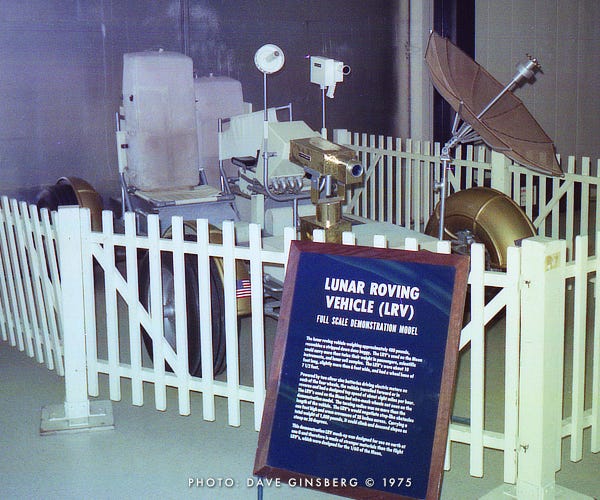
I believe this may be the same rover that – if you were in the right place at the right time – you might catch a glimpse of a real live astronaut using for lunar extravehicular training at the Cape.
The Visitor Information Center displayed a row of flown space capsules beginning with Mercury, then Gemini, and finally Apollo. I don’t know which Mercury mission that capsule was used for. According to a souvenir booklet I have from 1978, the Gemini capsule is likely from Gemini 9 crewed by Thomas Stafford and Eugene Cernan. The Apollo Command Module is identified by the sign that can be read in the photo as that used for the famous Apollo 13 mission. That’s me standing at the hatch opening. (Houston, we have a fashion problem.)
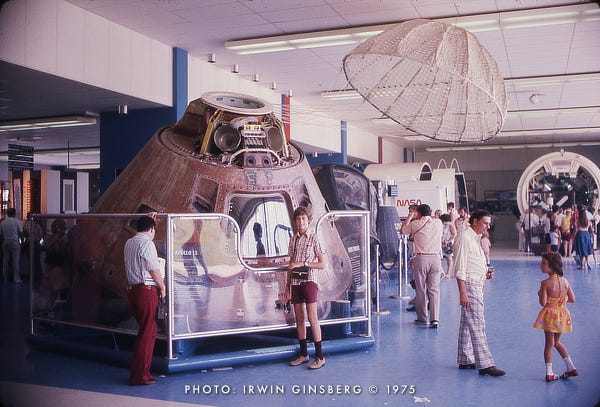
After our quick look at the exhibits, we headed outside to get in position to see the Viking launch. Here is a photo my dad took in the rocket garden. From left to right is a Jupiter-C with a mockup of Explorer 1, America’s first successful satellite; an example of the Apollo Command and Service Modules atop a Spacecraft Lunar Module Adapter (SLA); and a Gemini mockup sitting on a Titan II missile. Just visible on the extreme left edge of the photo is seen a sliver of a F-1 rocket engine built for use on the first stage of the Saturn V. Out of view was a Juno II booster.
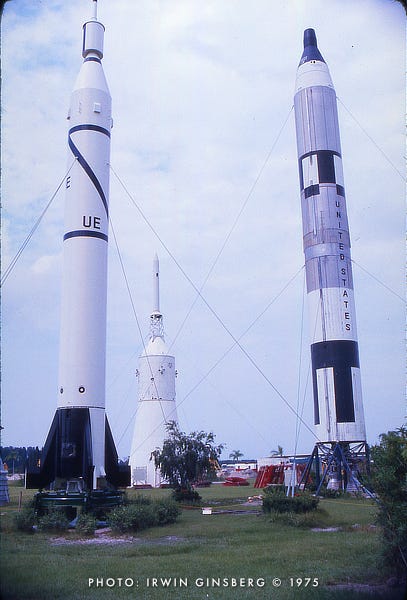
Let’s Light This Candle!
Viking 1’s launch was scheduled for 5:22 PM Eastern Daylight Time. At the expected time we saw the bright rocket exhaust plume rise above a line of nearby trees followed immediately by its smoke trail. Launch Complex 41, from which Viking lifted off, is about 7.3 miles (11.75 km) northeast of the Visitor Information Center. I remember initially hearing no sound from the rocket, only the oohs and aahs and camera clicking from the crowd. As the rocket rose higher, my hands began shaking from the excitement of seeing my first launch. I had trouble keeping my camera steady.
My dad had better control over his camera, which was a far better piece of equipment than mine. Here is a sequence of his shots of the launch of Viking 1 on its Titan IIIE-Centaur rocket. It was a fairly overcast day, so the show was brief, lasting only until the rocket entered the low cloud deck. This is how I remember it, albeit smaller through my camera’s tiny viewfinder. I couldn’t make out the rocket, itself. All I saw was the bright rocket exhaust plume and the smoke trailing behind it. But, wow, was it a thrill to see my first launch!
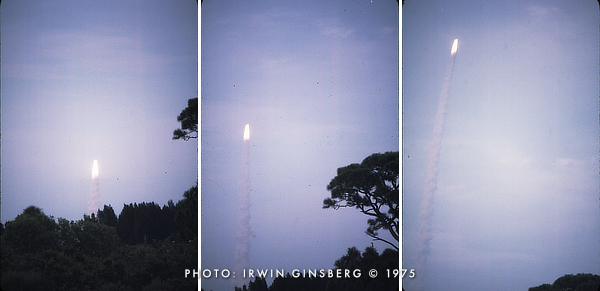
This is what the Viking launch looked like up close, courtesy of NASA’s professional photographers.
Just less than one year later, on July 1, 1976, while Viking was in orbit around Mars, a signal was sent to Earth that triggered a replica of the Viking lander’s robotic arm, taken from an engineering model, to cut the ribbon during the opening of the new Smithsonian National Air and Space Museum in Washington, D.C.
Michael Collins, Gemini and Apollo astronaut, was the director of the museum from 1971 to 1978, including the years during and after its planning and construction. He can be seen standing next to President Gerald Ford in the photo.
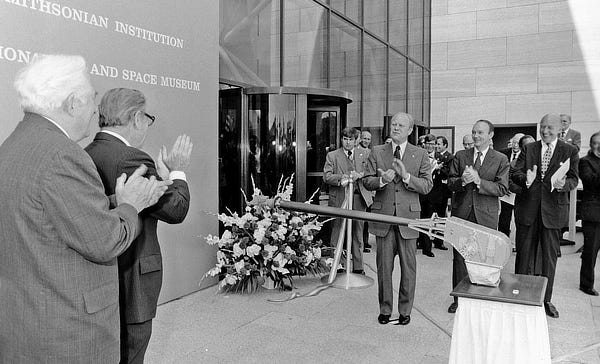
Up Up and Away TWA
After experiencing the spectacle of the Viking 1 launch, we boarded our tour bus to see some of the history-making NASA facilities.
Since 1966, the NASA bus tours had been operated by Trans World Airlines (TWA) of air travel fame. Before that time, beginning in 1963, self-guided driving tours were available.2
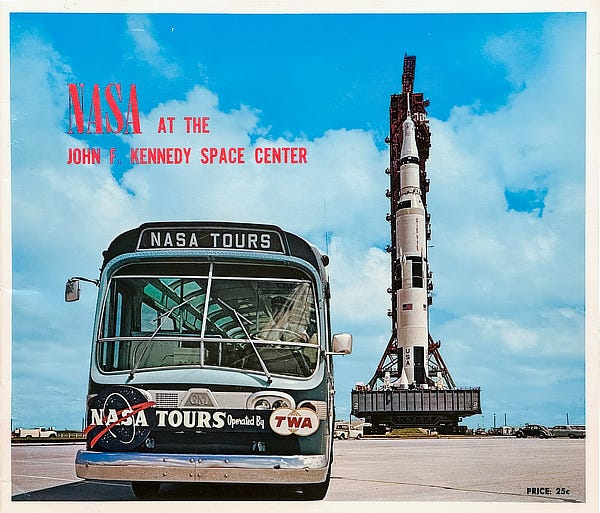
TWA really knew how to sell you on taking a bus ride. If the prospect of seeing a Saturn V rocket on the launch pad wasn’t incentive enough, maybe a lovely tour guide could entice you.
I was able to roughly retrace our tour route by referencing the order of photographs and pinpointing key landmarks and road characteristics. Here is a map you can follow along with.
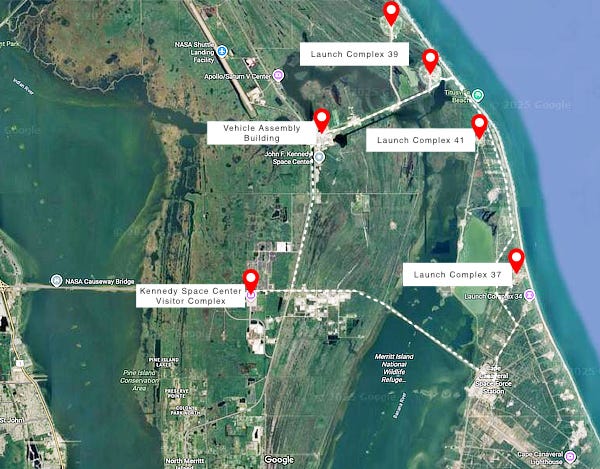
The first stop was the blockhouse at Launch Complex 37. LC-37, as it is known, consisted of two launch pads – LC-37A and LC-37B. It was built between 1959 and 1963 and was then the second site intended to launch the early Saturn rocket, together with LC-34. Its original purpose was to be the launch site for the Apollo approach to reaching the Moon known as Earth Orbit Rendezvous (EOR). As it was first envisioned, Saturn C-3 would launch both the trans-lunar injection stage and the Lunar Excursion Module from the two pads, while the crew would lift off from LC-34 and intercept the two payloads in low Earth orbit.3
Ultimately, EOR was scrapped in favor of Lunar Orbit Rendezvous (LOR) which employed a single Saturn V to launch all of the necessary components for a lunar landing and return to Earth. The Saturn V was launched from Launch Complex 39.
LC-37B was the launch site for Saturn I test flights between January 1964 and July 1965. Saturn IB test flights were flown from the same pad in July 1966 and January 1968.4
In 1998, the United States Air Force and Boeing came into an agreement to use LC-37 for launching the Delta IV as part of the Evolved Expendable Launch Vehicle program. The complex was officially put into active service with the first launch of the Delta IV on November 20, 2002. In 2014, the site was used to launch Exploration Flight Test-1 for NASA's Orion spacecraft. The launch vehicle was a United Launch Alliance Delta IV Heavy rocket.5
Here are some photos of the blockhouse at LC-37 from our tour.
Compare this photo my mother took with the NASA archive photo (below) of Dr. George Mueller giving a Saturn V orientation to President John F. Kennedy and other officials in the blockhouse at Launch Complex 37. The perspective is very similar and it is easy to pick out the periscopes and certain control panels in each one.
The members of the Apollo brain trust in the first row are (L-R) George Low, Dr. Kurt Debus, Dr. Robert Seamans, James Webb, President Kennedy, Dr. Hugh Dryden, Dr. Wernher von Braun, General Leighten Davis, and Senator George Smathers.6 I likely had no idea at the time that I was walking on such hallowed ground. It gives me goosebumps just to see this photo and to think that I was there just twelve years after that historic meeting. I know I would get the same goosebumps if I were to visit again in person today.
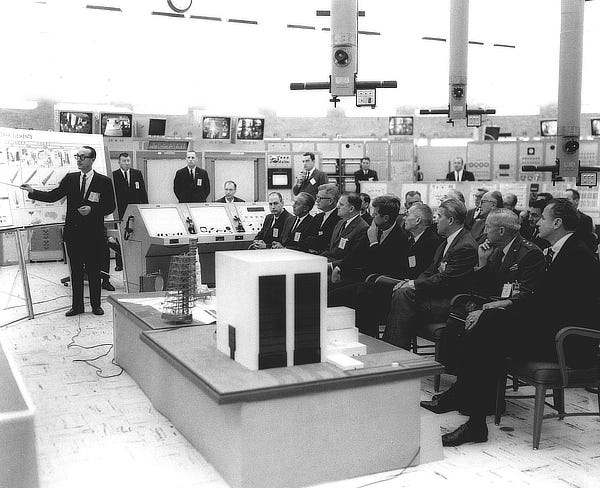
This archival NASA video about LC-34, a twin to LC-37, is well worth a watch to appreciate the scale and complexity of the ground operations and facilities necessary to support a large rocket such as the Saturn I.
Video: “Saturn: Launch Complex 34”, NASA Launch Operations Center via Cape Canaveral Space Force Museum
American illustrator Fred Freeman created a highly detailed depiction of the interior of a Saturn blockhouse, first as a 1964 study sketch, and then as a finished painting in 1968.
Freeman is renowned for his brilliant technical cutaway illustrations done for the 1952-1954 Collier’s magazine series, Man Will Conquer Space Soon, on early developments and possible futures in space exploration, as well as his participation in the NASA Art Program.
From the time I first saw the original painting at the National Air and Space Museum in the mid-1970s, I have been enthralled by the detail, albeit roughly rendered, and especially fascinated by the self-referential depiction of the artist drawing the sketch for the very painting it exists in. There’s no other way to say it other than, “It really draws me in!”
Here is the sketch done as a study for the final painting, above.
After the tour of the blockhouse, we took the bus up the coast, passing by Launch Complex 41 where Viking had launched from just an hour or so earlier. Here is a photo taken through the window of our bus as it was moving along the roadway.

Our bus driver then turned inland just south of Launch Complex 39. In this photo, LC-39A is seen on the left. Further in the distance toward the right of the photo is LC-39B with the launch umbilical tower and “milk stool” which had been used to launch the U.S.’s part of the Apollo-Soyuz mission atop an Apollo Saturn IB rocket. Mission Commander Thomas Stafford, Command Module Pilot Vance Brand, and Docking Module Pilot Donald K. (Deke) Slayton joined up with the Soyuz spacecraft crewed by cosmonauts Alexei Leonov and Valery Kubasov from the Soviet Union.
The Apollo-Soyuz mission had happened a month prior to our trip. I don’t know why our vacation was timed such that it just missed the final launch of a Saturn rocket – in this case a Saturn IB – but at least we got the consolation prize of watching the Viking launch.
Here’s a closer look at the milkstool – and what the launch of the elevated Saturn IB looked like via NASA’s cameras.
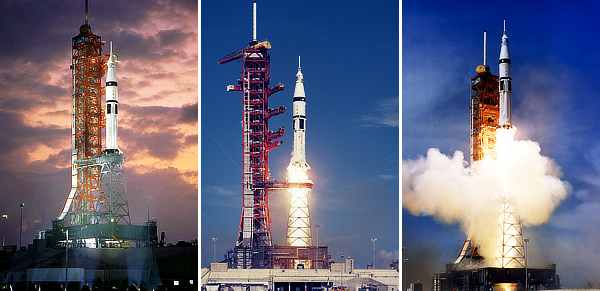
From there, we continued on toward the Vehicle Assembly Building (VAB). Here is a closer look at one of the launch gantries, parked outside the VAB, that was used for Apollo Saturn V launches. Eventually, these would be dismantled with parts repurposed or scrapped, with key pieces preserved for museum display. Part of the structure would be used for the upcoming Space Shuttle program. And much later, a brand new Launch Umbilical Tower would be constructed for use by the Artemis program.
As we arrived at the VAB, the photos indicate that the bus circled around and parked on the south side of the massive building and we were escorted inside.
On the walk over to the VAB, I asked the tour guide about the black and white markings on the Saturn V rocket. He tossed the question back to me, asking what I thought. I have clear memories of this. That simple act on his part made a lasting impression on me. It told fifteen-year-old me that I could be trusted to figure things out on my own.
Inside the cavernous building, it was essentially empty at the time we were there. The last Apollo mission had completed and there would be a six year gap in flights before the Space Shuttle would be ready to begin U.S. spaceflight operations.
I have very clear recollections of the remaining item of interest inside the VAB. A full-size high-fidelity Apollo-Soyuz with docking module was on display.
Again, my father’s photos turned out the best.
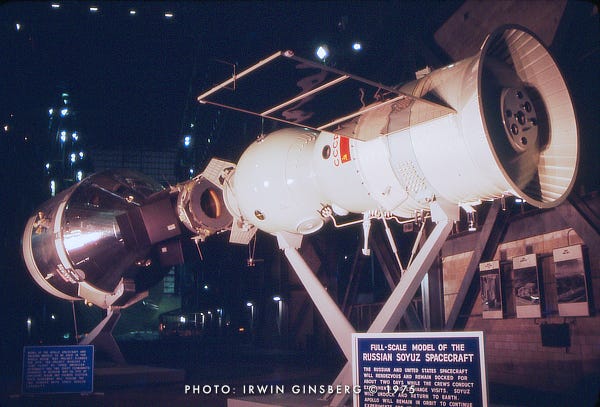
The Apollo Command and Service Modules were a test vehicle originally used for vibration and acoustic tests.7
From what I can tell from online sources and my own observations, I believe the Apollo half of the display was eventually moved to the new Smithsonian National Air and Space Museum for its opening in 1976. The Soyuz half may have been moved to another building at the Visitor Center at some point in time.89
The viewing angle my dad captured in his photo is reminiscent of space artist Robert McCall’s Apollo-Soyuz Linkup painted in 1974. I wonder if Dad had that painting in mind when he composed his shot.
Night at the Museum
Following the Vehicle Assembly Building tour, it was back to the Visitor Information Center for some last minute photos as they were closing.
Inside the Visitor Information Center was a mockup of the Viking lander. Here’s a photo I took after getting back from the bus tour. The clock on the far wall reads just after 8:00 and judging by the absence of the crowds we experienced when we arrived, it appears we must have closed down the place. (By the way, that is not the only time I have found myself being one of the last people in the KSC visitor complex, but that is perhaps a story for another day.)
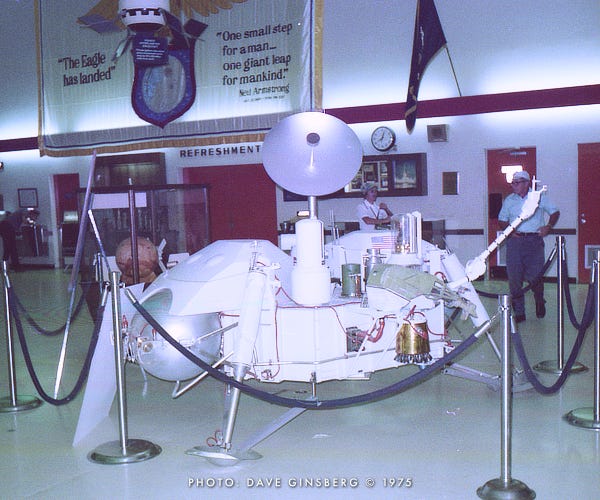
If I were to ask you what looks unusual about this display, I wonder if you would pick out what I notice. The lander mockup is just sitting on the linoleum floor with only a black velvet rope separating it from curious hands. No plexiglass enclosure, no description sign that I can see, no simulated Martian surface, not even a plain black base to elevate it off the floor. Exhibit display practices have come a long way since then.
Another couple of traits I picked up from my dad were photographic composition and attention to detail. For example, I present these next photos my father hurriedly took in the fading light outside in the rocket garden. I can tell that he was trying his best to capture the near-full rising Moon in his shots together with the Lunar Module mockup. The symbolism was not lost on him.
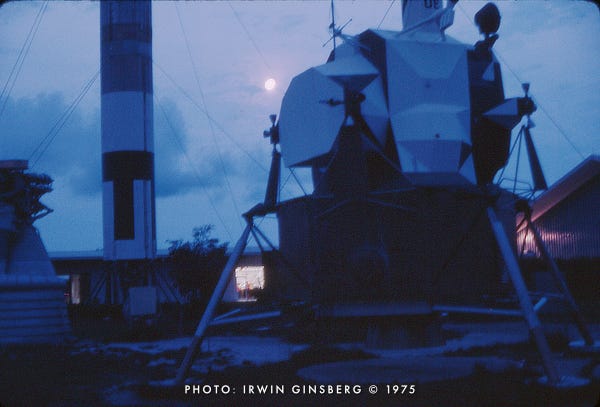
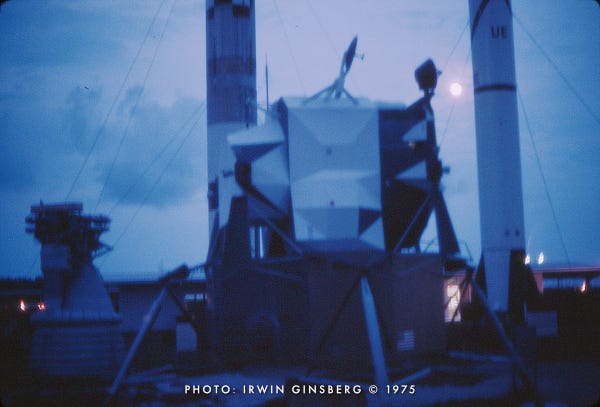
Then and Now
As I reflect back on that impressive first visit to the Kennedy Space Center, I see it as one of the defining moments in my life. It was an important contributor to solidifying and reinforcing my interests in spaceflight, and qualifying my admission into a global community of fellow Space Geeks. To this day, I still carry those interests and have preserved my fascination with spaceflight history and the future of space exploration.
I have returned to the Kennedy Space Center many times since that first visit in the summer of 1975.
Here’s a then and now pair of photos showing me with a Skylab Multiple Docking Adapter (MDA) Full-Scale Engineering Mockup and One-G Trainer – first in 1975, then in 2018.
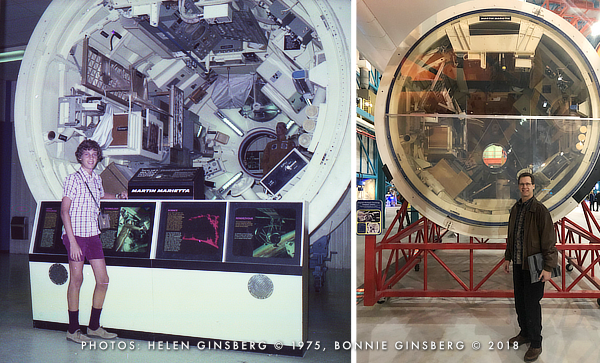
Here I am connecting with my first love in 1975 – the 1/10 scale cutaway model of the Apollo Saturn V at the KSC Visitor Information Center. It is still displayed, now beside the real thing in the Saturn V Center.
In total, I have made the pilgrimage to the Kennedy Space Center eight times, so far. I see no signs of stopping as long as there is history to be absorbed and there are launches to be experienced.
I saw my first Space Shuttle launch (Discovery, STS-96) in 1999 during another trip with my dad. In 2010, I was there to see my artwork launch aboard Atlantis (STS-132). I was there for a scrubbed launch attempt of Endeavour in 2011 (STS-134), and witnessed the last Space Shuttle launch later that same year (Atlantis, STS-135).
I went back in 2018 to display my artwork in the Atlantis pavilion during the Constellation Foundation’s fiftieth anniversary commemoration of Apollo 8.
And, I have been back twice in the past two years while participating in the space art shows for the Astronaut Scholarship Foundation’s Astronaut Hall of Fame events.
Never would I have thought, back in 1975 during a family vacation to the Kennedy Space Center, that I would be back to pay homage to our country’s space achievements so many times. And, fifteen-year-old me could not have dreamed that I would have my space-inspired artwork on display there – and never in a million years could I have predicted that my artwork would be launched on a space plane from one of the very launch pads used for the Apollo missions.
Curiosity and imagination never leave you if you continue to nurture them with experiences that fill you with awe and wonder.
Merch of the Month
Magnificent Ride Giclée Print
Magnificent Ride celebrates the Saturn V rocket which boosted the Moon-bound Apollo missions to their celestial targets. In this piece, I have attempted to capture the awesome beauty of the giant exhaust plume from the Saturn V’s first stage rocket engines.
I'm Dave Ginsberg, the artist behind Pixel Planet Pictures and writer of Creating Space.
I am an artist and a creative engineer with a love for teaching and passions for spaceflight, astronomy, and science. My space-inspired art portfolio can be found at pixel-planet-pictures.com.
Do you know fellow Space Geeks who might enjoy Creating Space? Invite them into this space, too!
Did you miss a post? Catch up here.
If you enjoyed this article please hit the ‘Like’ button and feel free to comment.
All images and text copyright © Dave Ginsberg, unless otherwise noted. All rights reserved.
Cape Canaveral Space Launch Complex 37, https://en.wikipedia.org/w/index.php?title=Cape_Canaveral_Space_Launch_Complex_37&oldid=1301930352 (last visited Aug. 23, 2025)
Space Center’s Visitor Complex: A Window into NASA Operations, America’s Spaceport – Part 4, Bob Granath, July 27, 2022
Cape Canaveral Space Launch Complex 37, https://en.wikipedia.org/w/index.php?title=Cape_Canaveral_Space_Launch_Complex_37&oldid=1301930352 (last visited Aug. 23, 2025)
Kennedy at Cape Canaveral, NASA on The Commons Flickr
Command and Service Modules, Apollo #105, ASTP Mockup, Smithsonian, Air and Space Museum (https://www.si.edu/object/command-and-service-modules-apollo-105-astp-mockup%3Anasm_A19740798000)
Apollo-Soyuz Test Project Display at the National Air & Space Museum, Heroic Relics, Mike Jetzer (http://heroicrelics.org/info/nasm/astp-display.html)
dsc07290.jpg, Soyuz Model Gallery, Heroic Relics, Mike Jetzer (http://heroicrelics.org/ksc/soyuz/dsc07290.jpg.html)




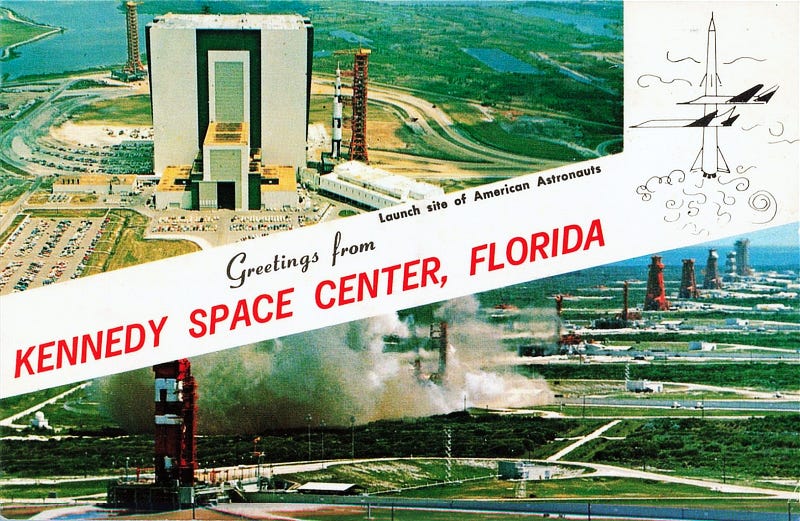
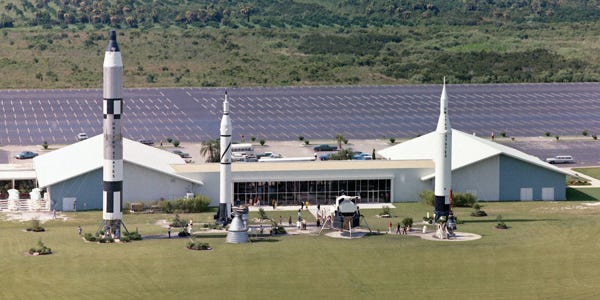
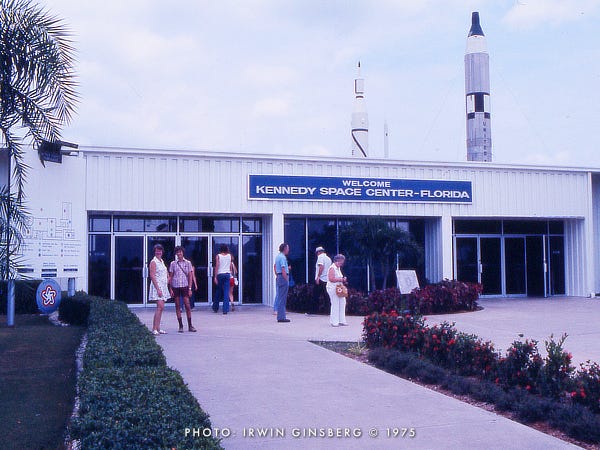


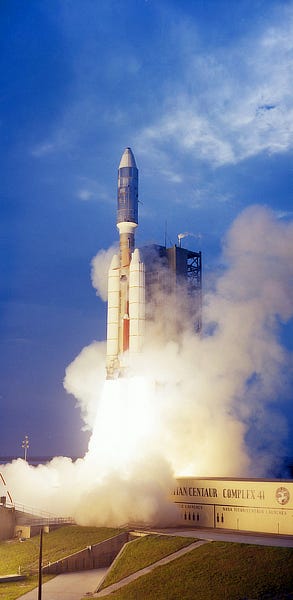


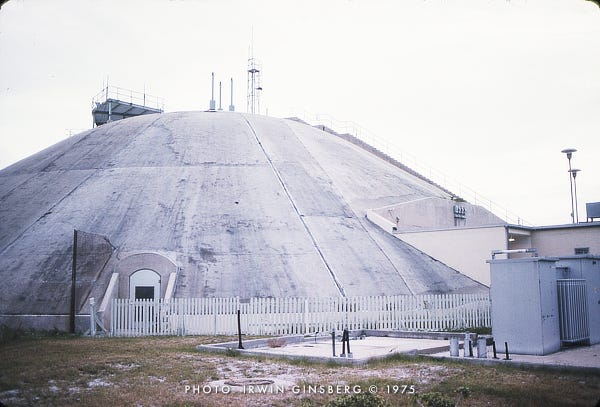
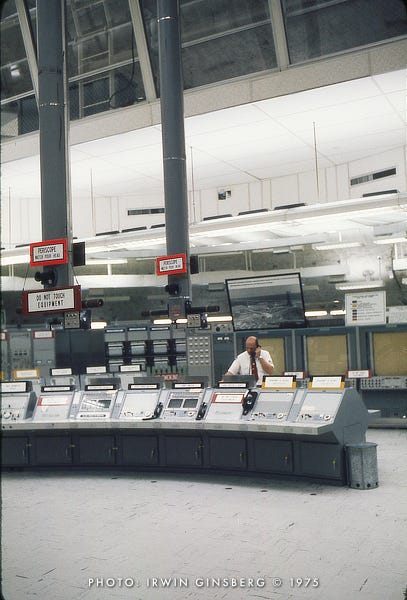
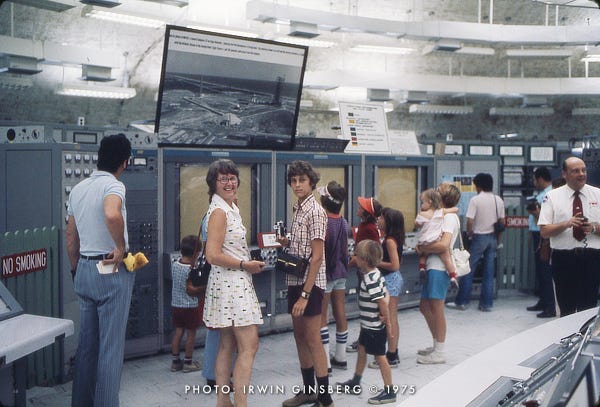
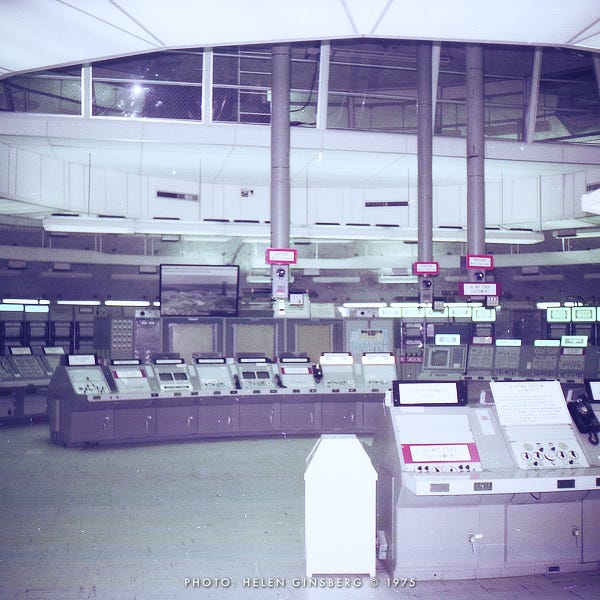

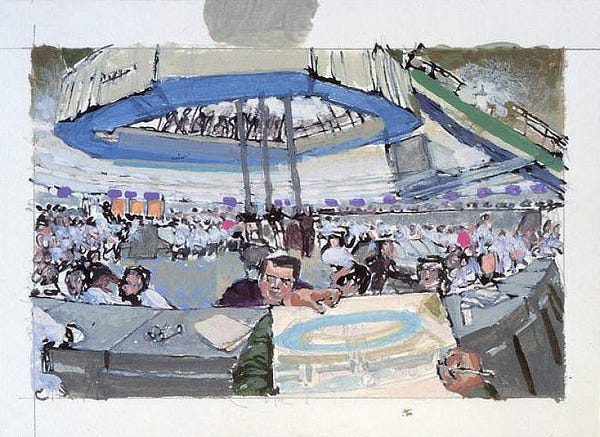

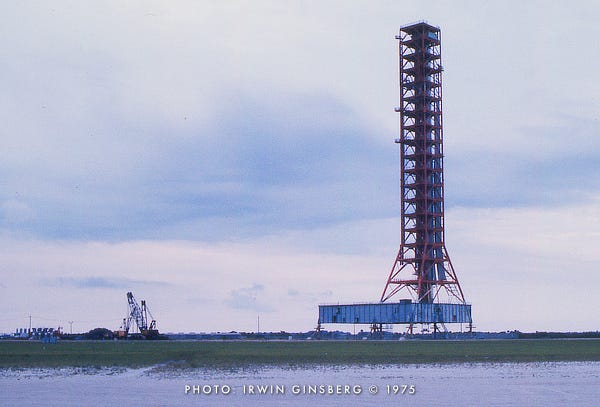
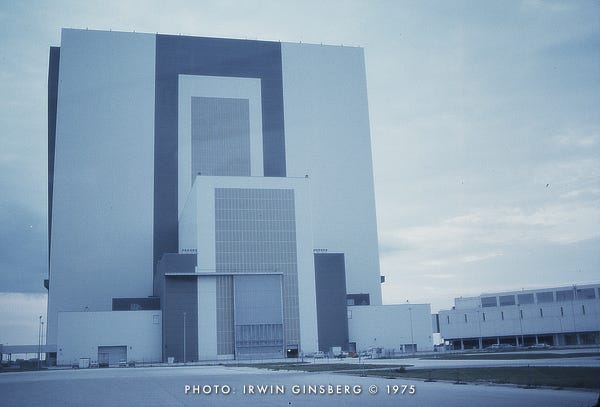

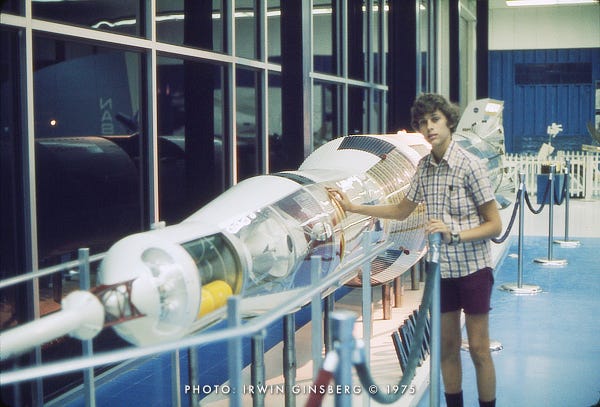
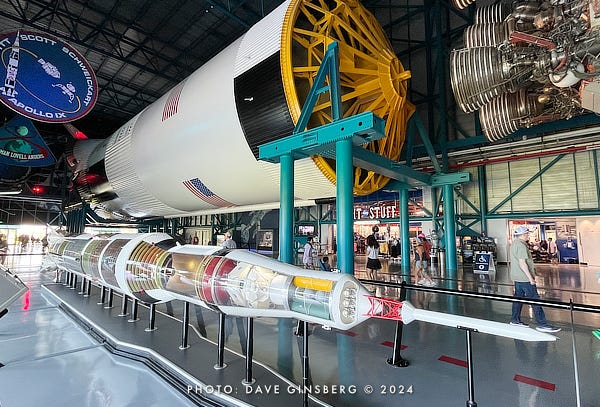



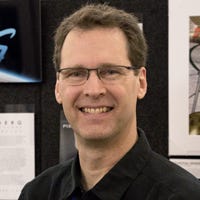


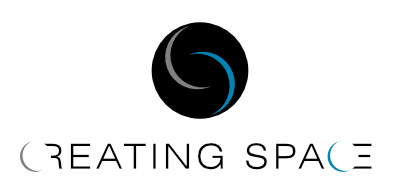
Great piece! You'll have to get to Hutchinson to see Odyssey in its permanent home now that the Cosmosphere has finished up the renovation project in the hall of space.